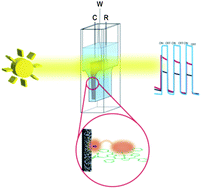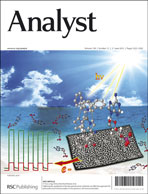The substituted porphyrin 2-cyano-3-(2′-(5′,10′,15′,20-tetraphenyl porphyrinato zinc-(II))yl) acrylic acid was used to modify nanostructured Ag surfaces. This porphyrin-modified surface exhibits photocurrent when exposed to a light source, which is modulated in the presence of nucleotides. The addition of the nucleotides adenosine-5′-monophosphate (AMP), guanosine-5′-monophosphate (GMP) and cytidine-5′-monophosphate (CMP) causes partial quenching of the photoelectrochemical response of the porphyrin. The quenching efficiency is 80%, 68% and 48% for AMP, CMP and GMP, respectively. This work represents a new aspect of Ag NS substrates and highlights their usefulness as transducers a for potential chemosensor systems.
You have access to this article
 Please wait while we load your content...
Something went wrong. Try again?
Please wait while we load your content...
Something went wrong. Try again?


 Please wait while we load your content...
Please wait while we load your content...